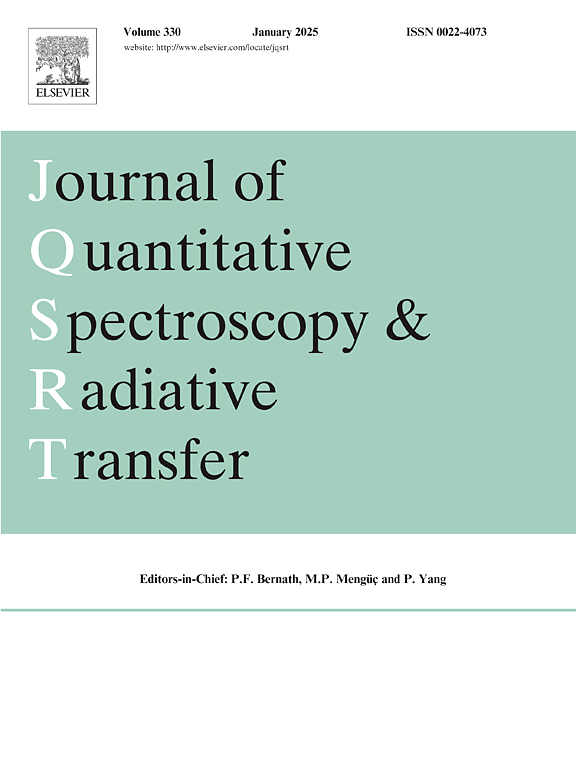Accurate potential energy surface, dipole moment surface, and IR line lists for OCS isotopologues up to 2000 K
IF 2.3
3区 物理与天体物理
Q2 OPTICS
Journal of Quantitative Spectroscopy & Radiative Transfer
Pub Date : 2025-03-08
DOI:10.1016/j.jqsrt.2025.109425
引用次数: 0
Abstract
We report high-quality IR line lists of carbonyl sulfide (OCS) computed using an ab initio potential energy surface (PES) refined with selected energy levels from HITRAN2020 and experimental energies for highly excited vibrational states, and CCSD(T)/aug-cc-pV(T/Q/5+d)Z dipole moment surfaces (DMS). With PES accuracy σrms < 0.01 cm-1 for 16O12C32S levels and DMS fitting σrms = 1.3×10–7 au for potential energy < 15,000 cm-1, room-temperature IR line lists are generated for 12 OCS isotopologues in the 0–15,000 cm-1 range with S296K > 10–31 cm-1/molecule.cm-2, then combined into a composite line list of 9 million transitions, denoted Ames-296K. For high-temperature applications, an Ames-2000K OCS line list is constructed in the same range, including 7 OCS isotopologues, with J ≤ 240 and E' ≤ 23,000 cm-1 for 16O12C32/34S. The Ames line lists are compared to HITRAN, CDMS, JPL(2010) near-IR line list, ExoMol line list for 16O12C32S, and high-resolution experimental IR studies. Data issues and discrepancies are identified and discussed. The accuracy of energy levels and line positions in the Ames line lists have been further enhanced using reliable experimental-based effective Hamiltonian (EH) models from HITRAN, or more consistent 0th-2nd order adjustments derived from the band-by-band comparisons between EAmes and EMARVEL, ECDMS, and experimental data and models. We demonstrate the reliability and consistency of theoretical calculations may be utilized to determine more consistent empirical line positions, compared to direct MARVELization. The Ames-296K line list is evaluated against Pacific Northwest National Laboratory experimental cross sections, showing widespread improvements over HITRAN and ExoMol line lists in the range of 600–6500 cm-1. The Ames line lists with empirically corrected line positions will provide accurate, reliable, and more complete IR predictions to facilitate OCS spectra analysis and modeling in atmospheric and exoplanetary studies. The PES, DMS, and line list files are available online to public.
求助全文
约1分钟内获得全文
求助全文
来源期刊
CiteScore
5.30
自引率
21.70%
发文量
273
审稿时长
58 days
期刊介绍:
Papers with the following subject areas are suitable for publication in the Journal of Quantitative Spectroscopy and Radiative Transfer:
- Theoretical and experimental aspects of the spectra of atoms, molecules, ions, and plasmas.
- Spectral lineshape studies including models and computational algorithms.
- Atmospheric spectroscopy.
- Theoretical and experimental aspects of light scattering.
- Application of light scattering in particle characterization and remote sensing.
- Application of light scattering in biological sciences and medicine.
- Radiative transfer in absorbing, emitting, and scattering media.
- Radiative transfer in stochastic media.

 求助内容:
求助内容: 应助结果提醒方式:
应助结果提醒方式:


